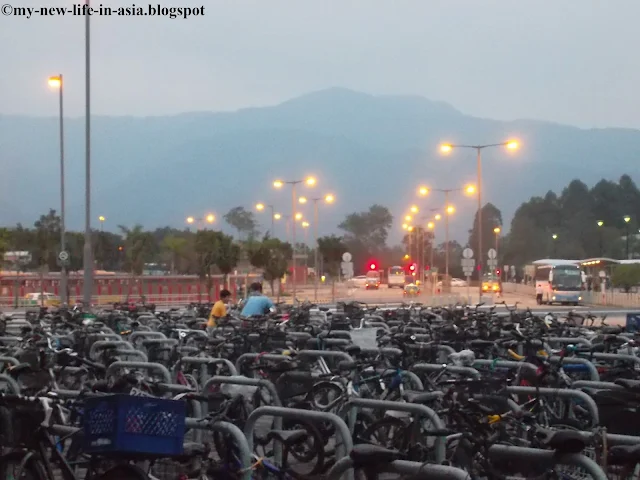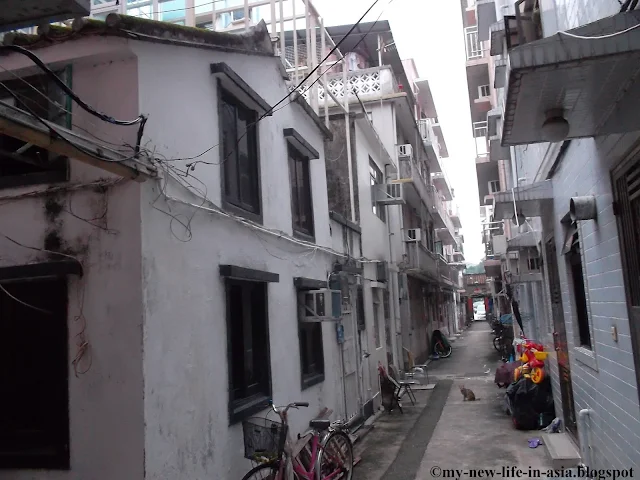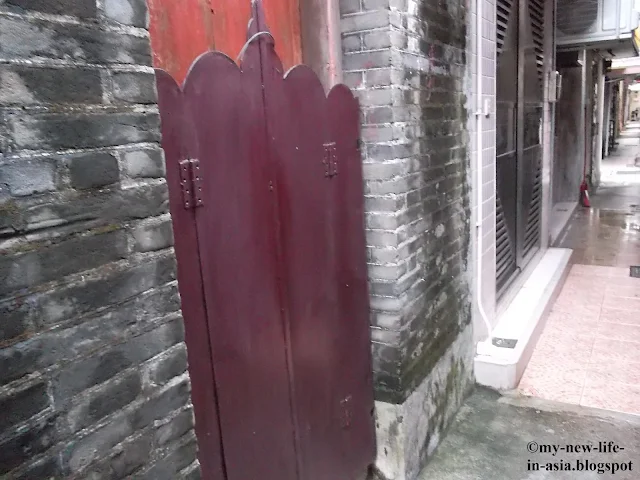Kat Hing Wai (吉慶圍; Mandarin pinyin: Jíqìng wéi) is an ancient walled hamlet in Kam Tin village (錦田; Mandarin pinyin: Jǐn tián) , one of the oldest settlements in Hong Kong's New Territories.
It is located in Yuen Long District, in the northwestern part of Hong Kong. The district borders on Shenzhen in mainland China.
To get to Kam Tin village you can take the purple line towards Tuen Mun and get off at Kam Sheung Road MTR Station. Kam Tin town and Kat Hing Wai village are only around 10-15 minutes on foot from the station (see map below).
| Yuen Long District, in Hong Kong's New Territories |
When I arrived at Kam Sheung Road Station, I was very surprised; I felt as though I was not in Hong Kong any more, but in a small, sleepy Chinese town on the countryside. There were no skyscrapers, no crowded streets or traffic jams. In front of the MTR station there was a huge square and a flea market, people strolled leisurely around. The rural character of this district makes it also a good place for cyclists, and in fact there were plenty (riding a bike is almost an impossible task in the city). The quiet rushing of a recently opened canal and the chirping of birds, instead of the ceaseless clamour of cars and buses and trams, were the background noises of Yuen Long.
 |
| Kam Sheung Road MTR Station |
 |
| Large roads and plenty of space. Completely different to what you will see in other districts of Hong Kong. |
 |
| Bridge connecting the square in front of Kam Sheung Road Station with Kam Sheung Road. |
 |
| Flea market in front of the station |
Kat Hing Wai
Kat Hing Wai (literally: "Walled Village of Lucky Fortune") is one of five walled villages inside the larger town of Kam Tin. It is "perfectly regular in plan, featuring a main central lane, flanked on both sides by identical rows of houses facing the same direction" (Lung 1999 , p. 34).
, p. 34).
The structure of the village reveals its defensive nature: neighbouring rivals, pirates and bandits posed constant threats to the safety of the villagers (Rodwell 1991, p. 37). Kam Tin was founded by the powerful Tang clan, which was one of the first families to settle in the New Territories back in the 11th century.
The structure of the village reveals its defensive nature: neighbouring rivals, pirates and bandits posed constant threats to the safety of the villagers (Rodwell 1991, p. 37). Kam Tin was founded by the powerful Tang clan, which was one of the first families to settle in the New Territories back in the 11th century.
 |
| The defensive walls of Kat Hing Wai |
Origins of Kam Tin settlement and Kat Hing Wai
The northwestern part of the New Territories was home to some of the earliest settlements of Hong Kong. The Yueh people who inhabited the region were conquered by the first Chinese emperor, Qin Shi Huang-di (259 BC – 210 BC), who incorporated Hong Kong into his empire (Rodwell 1991, p. 22). Hong Kong became part of Guangdong Province, and it remained so until the British established their rule over the New Territories in 1898.
The Chinese authorities built several forts in the region, the most important of which was in Tuen Mun, which had a garrison and, after the fall of the Tang Dynasty, also a naval force (ibid., p. 24). Before the Song Dynasty (960-1279) there seem to have been only sporadic Han settlements. During the Song era, however, Cantonese-speaking immigrants began to move southwards and founded villages there.
Among the families, or clans, which arrived in the New Territories, was the Tang clan (鄧族; Mandarin pinyin: Dèng zú), which was the most powerful and influential in the area. In the 11th century Tang Fuxie, who was a member of the gentry and a scholar from Jiangxi and who had served as a magistrate in Guangdong, acquired land in the New Territories and founded the village of Kam Tin (ibid., p. 24-25).
The Tang clan settled in the most fertile part of Yuen Long plain and developed both agricultural and industrial activities thanks to which the wealth and power of the family grew considerably (see Lung 1999, p. 32). The Tangs' possessions were scattered all over southern China: they had lands in Dongguan, Jiangxi Province, as well as Hong Kong's New Territories and Lantau island (Rodwell 1991, p. 25).
The Tang clan settled in the most fertile part of Yuen Long plain and developed both agricultural and industrial activities thanks to which the wealth and power of the family grew considerably (see Lung 1999, p. 32). The Tangs' possessions were scattered all over southern China: they had lands in Dongguan, Jiangxi Province, as well as Hong Kong's New Territories and Lantau island (Rodwell 1991, p. 25).
The tides of history allowed the Tang family even to intermarry with the imperial family. In 1127, when the Mongols invaded China, a princess of the imperial house managed to escape from the Song capital Kaifeng and took refuge in Jiangxi, where Tang Xian of the Tang clan was serving as a magistrate. He sent the princess to the more secure Kam Tin, where the princess subsequently married Tang Xian's son, Tang Sze-ming. When the Song emperor repelled the Mongols, he gave Tang Sze-ming a title and a large dowry (ibid.).
In 1644 the Ming Dynasty (1368–1644) was overthrown by invaders from Manchuria, who established the Qing dynasty (1644-1912). The Qing faced major challenges in the coastal regions. From the 15th century Japanese pirates had been a thorn in the side of the Chinese Empire, for they regularly launched attacks in Guangdong, threatening the local population and compromising the security of the sea. At the same time, European powers, most especially the Portuguese, started to expand their trade in Asia. Moreover, Zheng Chenggong (known in the West as Koxinga), a Ming royalist, had retreated to Taiwan with the purpose of recovering mainland China and repulse the Qing (ibid., pp. 26-28). It was therefore vital for the survival of the Qing Dynasty to neutralize these three combined threats coming from the sea.
Since the local population on the coasts was often forced by invaders to provide them with food and provisions, the Viceroy and the Governor of Guangdong Province ordered the inhabitants of coastal areas to abandon their homes and move 17 miles inland. This proved to be economically disastrous for the population of Hong Kong who had to leave their farmland, which was their only source of income.
The ordered evacuation failed to quell piracy and foreign invasions, because the uninhabited coasts were easier to occupy. In 1699 the Governor of Guangdong realized his debacle and allowed the resettlement of the coastal regions. During this second wave of immigration, many Hakka people - an ethnic subgroup of the Han - were encouraged to move to the New Territories. Therefore Hakka culture partly reshaped the architecture and customs of Hong Kong (Rodwell 1991, p. 28; Lung 1999, p. 33).
When the British took over the New Territories in 1898, Kam Tin was one of the last anti-British strongholds. First, the Tang clan fought against British troops in Shek Tau Wai, about 2 km east of Kam Tin, and were defeated. In search of the leaders of the rebellion, the British surrounded Kat Hing Wai, and after a siege, the villagers surrendered and, as a gesture of submission, handed to the Governor of Hong Kong, Sir Henry Blake, the iron gates of the village (Lee / Di Stefano 2002 , pp. 69-71). The gates were brought by Blake to Britain, and twenty-six years later, upon request of the Kat Hing Wai's village elder Tang Pak-kau, they were returned to the village.
, pp. 69-71). The gates were brought by Blake to Britain, and twenty-six years later, upon request of the Kat Hing Wai's village elder Tang Pak-kau, they were returned to the village.
Kat Hing Wai Today
Kat Hing Wai and Kam Tin have partly retained their rural character, at least when compared to other areas in Hong Kong. The villages are still populated by the descendants of the Tang clan, and Tang remains a very popular surname (Lee / DiStefano 2002, p. 28; p. 109).
In old times houses were built of mud bricks or clay bricks, and lacked all the facilities and comforts of modern buildings. There were no paved streets, and all around there were the paddy fields where the villagers worked (ibid., p. 122). In the decades that followed Hong Kong's economic take-off (from the 1960s onward), many of those old houses were demolished, and new ones, known as "Spanish-style villas" replaced the traditional structures. They may look less interesting to tourists but are definitely more comfortable to live in (ibid., p. 110).
 |
| This is the main entrance of the village, with the iron gates given back by the British |
 |
| I am not sure if this building, which is at the end of the main lane of the village, is a temple or an ancestral hall |
 |
| A narrow side alley |
 |
| The main gate as seen from inside the village |
 |
| An old house. It actually looked abandoned |
 |
| In this alley there are several old structures |
 |
| This shrine is right next to the main gate |
 |
| Some of the residents must be People's Republic of China patriots. This is - so far - the only PRC flag I have seen fluttering above a private house in Hong Kong |
 |
| This seems to be an illegal settlement, at least by the look of the buildings, but I'm not sure. I saw a lot of Nepalese Hong Kongers living here |
 |
| There is a reason why in this area no building exceeds two or three floors. It is a government regulation that dates back to colonial times. |
The following episode shows how the old village traditions have survived in many villages of Yuen Long. In 1979 Prince Charles visited Hong Kong to inaugurate the Prince of Wales Building (now People's Liberation Army Forces Hong Kong Building). He expressed his wish to visit some old villages. Shui Mei Tsuen (one of the many "Tang Villages" in the area) was chosen for this purpose, and the government sent representatives to the head of the village, Tang Tim-kau to ask him if Prince Charles could go to see the village. Tang Tim-kau (85 years old in 1998), however, told to the shocked delegation that the prince could not go to visit Shui Mei Tsuen.
There was a reason behind Tang Tim-kau's refusal. For some time, he had put pressure on the government to built paved roads in his village, but the government had rejected his requests because it deemed the village too small. Now, Tang Tim-kau saw an opportunity to achieve his goal. In an interview given in the 1990s, Tang Tim-kau stated: "I told them that I couldn't possibly invite the prince into our village without a properly paved road. They got the message and a few days later, the District Office sent a surveyor with a letter promising to have the road built" (ibid., pp. 123-124).
In Kam Tin I saw a lot of people who looked like "immigrants". I mistakenly thought they were Pakistani workers or something of the kind. Instead, they are as local as the Han Chinese. They are Nepalese Hong Kongers, descendants of Gurkha soldiers who were stationed in Shek Kong Camp (which is now part of the garrison of the People's Liberation Army).
After the Sino-British talks of the 1980s it was decided that Hong Kong would be handed over to the PRC, and the Nepalese troops, as part of the colonial army, had no function any more and were disbanded. Many Nepalese who had been living in Hong Kong with their families decided to stay, and their children became permanent residents. Nowadays, around 2,000 Nepalese Hong Kongers live in 13 villages in the Kam Tin area.
___
Thank you for reading this post. If you want to support my work, you can check out my support page. Thanks!
































Comments
Post a Comment